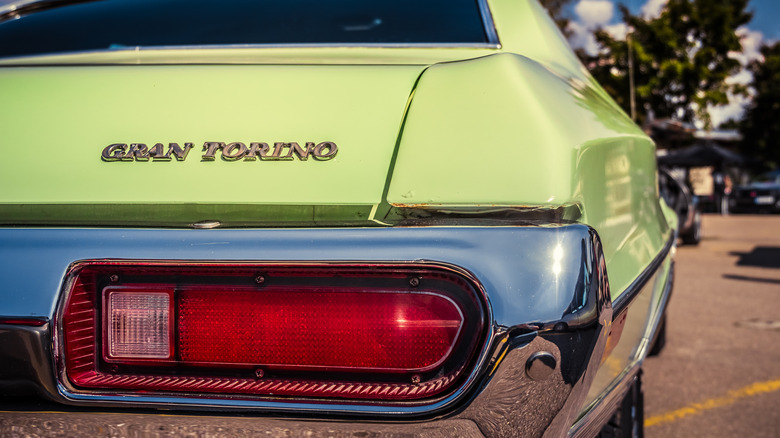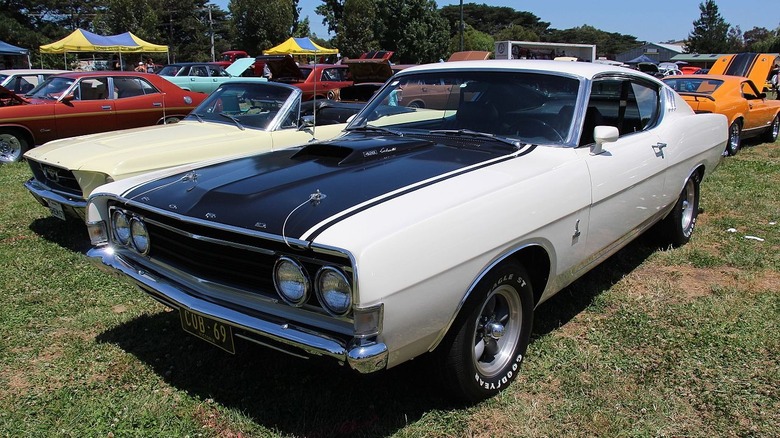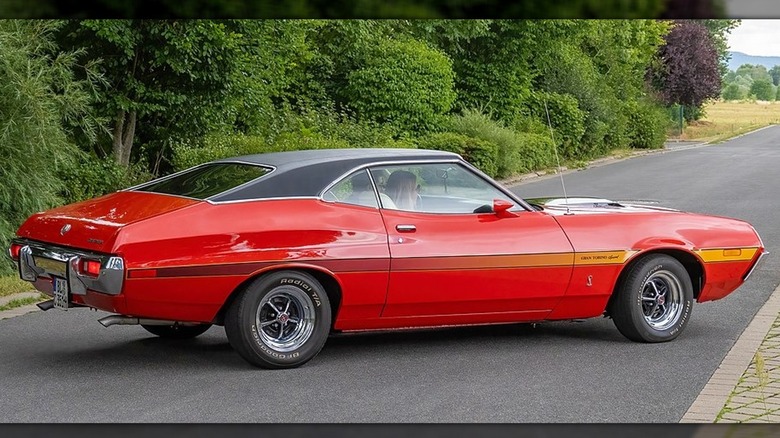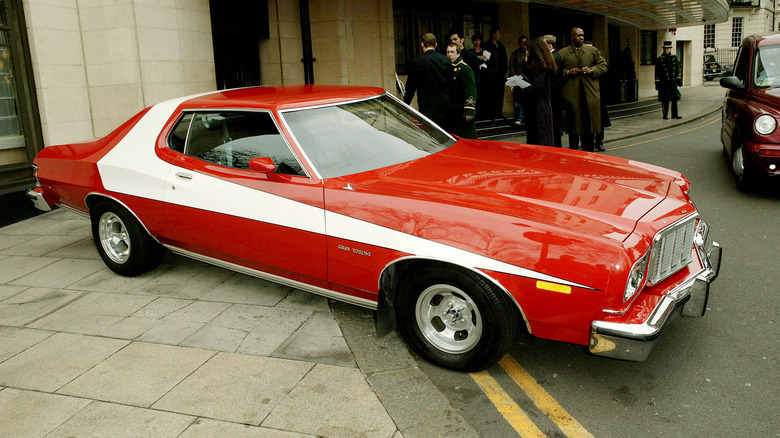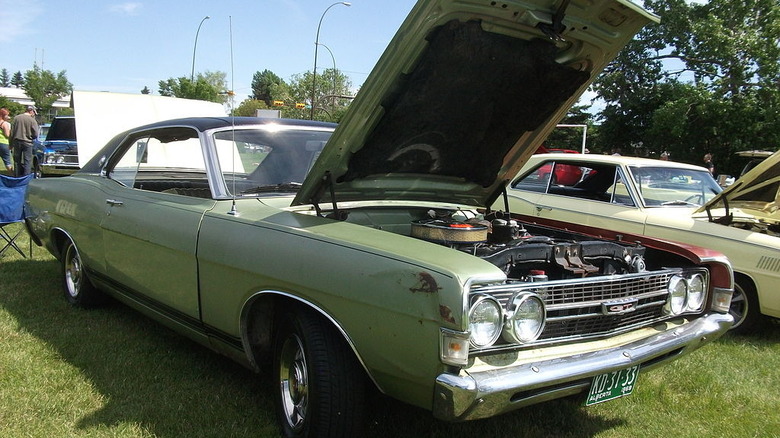Why The Underappreciated Ford Torino Is Cooler Than You Remember
In 1968, Ford released the Torino as a high-end package upgrade to the Fairlane, a full-sized car it'd been making since 1955. In two short years, it had become such a hit that the Blue Oval decided to retire the Fairlane name — which had existed for seven generations and included station wagons, two-door hardtops, and convertible – and turn the Torino into its own line of automobiles. The Torino tag comes from the city of Turin, Italy, often called "the Italian Detroit." Interestingly enough, even before it rolled out as an upgrade option, the name had made its way onto Ford's shortlist as the moniker for what would be called the mighty Mustang.
Things worked out for Ford because the Mustang is, well, the Mustang, and in 1970, the Torino won Motor Trend's Car of the Year. Like the Fairlane, the Torino variants had everyday drivers, including two-door hardtops, four-door sedans, station wagons, and even a utility vehicle (the Ranchero). Sportier models like a convertible, the GT coupe, and a fastback SportsRoof version were also available. With its standard 302 V8 (a 390 was an option) and spruced-up deluxe interior, some consider the GT Ford's first foray to turn the Torino line into what Motor Trend referred to as a system of "specialty cars" — most of which would go on to blow the minds of enthusiasts during the golden age of the muscle car and cement it as a truly unique line of automobiles.
[Featured image by sv1ambo via Wikimedia Commons | Cropped and scaled | CC BY-SA 2.0]
A solo star is born
Alas, we're getting ahead of ourselves, so let's return to 1969 when Ford dropped two different Torino "specialty cars." The Cobra is a supercharged Carroll Shelby-inspired variation to the already sporty GT. Meant to go toe-to-toe with Plymouth's RoadRunner, it was equipped with a heavier tuned suspension, a pair of bucket seats, cobra decals, and the coup de grace — a standard 428 big-block engine. A Twister version strapped with a drag package that included a shaker hood, front power disc brakes, and Traction-Lok differential came out in 1970, but Ford only made 90 of them.
Meanwhile, the Talladega was built to homologate for NASCAR competition and is considered by most collectors to be the "Holy Grail" of Torinos. Approximately 754 of these SportsRoof variants were made. It was powered by Ford's four-barrel 428 cid V8 Cobra Jet engine, kicking out 335 hp and 440 lb-ft of torque, and had an enhanced aerodynamic nose, flush grille, and special rockers.
This version of the Torino snake bit NASCAR hard, winning back-to-back Grand National Series titles. Before a third checkered flag was waved, NASCAR changed the rules and forced Ford to park the Talladega next to two other "aero-cars" – Plymouth's Superbird and Dodge's legendary Daytona Charger – at the "Banned from the Track" Hall of Fame. Three King Cobra prototypes were (again) built for NASCAR racing, but the project was canceled and never made it to production.
[Featured image by Sicnag via Wikimedia Commons | Cropped and scaled | CC BY-SA 2.0]
The Torino redesign ushered in the Coke-bottle body
Regardless, the NASCAR victories combined with all the media buzz sent Torino sales through the roof and convinced Ford to make it a full-fledged solo star in 1970. As the saying goes, out with the old (Fairlane) and in with the new (Torino). While a radically redesigned Talladega failed to win another NASCAR race, Ford (once again) made out just fine because the redesigned Torino wowed the masses and the media so convincingly that it won Motor Trend's coveted Car of the Year award in 1970.
The pinnacle of the '70s normal Torino models was the Brougham trim option, which bedazzled with new exterior moldings and retractable headlights. The GT received a hood scoop and some new decals, while the Cobra got a much bigger boost with a black center hood with pins and a functional scoop, rear louvers, and a competition suspension. All three remained mostly unchanged in 1971.
In 1972, however, Ford revamped the line again, this time reducing choices from 14 down to nine (i.e., two-door hard top and fastback options, four-door sedan, and five-door estate wagon). It also unveiled the Gran Torino and Gran Torino Sport packages for the first time. Another redesign choice was the more pronounced "Coke-bottle" body styling, which lowered, lengthened, and widened the SportsRoof to appear more aggressive than previous models while making the nose tapered and wider than the back, a design choice reportedly taken from the SR-71 Blackbird.
[Featured image by Reinhold Möller via Wikimedia Commons | Cropped and scaled | CC BY-SA 4.0]
A striped tomato never looked so good
Frame construction was changed to a body-on-frame design, while car enthusiasts could beef up the suspension with Ford's new four-link suspension and coil springs in the rear. Surprisingly, front disc brakes were standard equipment that no other carmaker offered in that class at the time. The base model Torino had "dog-dish" wheel covers, high-back bench seats, floor mats, and a 250 cid six-cylinder engine mated to a three-speed manual transmission.
The Gran Torino package added options for a high-performance V8, a deluxe interior with wood covers, carpeting, side moldings, cloth and vinyl trim, twin horns, a DeLuxe steering wheel, and front disc brakes. The even higher-performance Gran Torino Sport had a 302 cid V8 that produced 140 hp. It came with a hood scoop, vinyl-pleated seats and trim, sports mirrors, and a distinctive grill.
The Gran Torino is probably the most famous of all the "specialty cars," at least in the minds of the general public, thanks to its starring role as the vehicle buddy cops "Starsky & Hutch" drove around in. That bright red paint job with the Wimbledon White stripe (aka, the "Striped Tomato") went on to make an indelible skid mark in pop culture history. It and the Sport were basically neutered in '72 thanks to the oil crisis and subsequent emissions restrictions, which forced automakers to lower compression and throttle back the horsepower.
Ford's Torino came with many engine options
Ford also switched from using SAE Gross ratings for horsepower to SAE Net (which deducted the drain used by accessories and transmission), making engine specs look even more feeble. At the same time, insurance companies were dropping the hammer on muscle cars. In '73, Ford made some cosmetic changes and tweaked some things under the hood. It did away with the SportsRoof entirely in '74. During the Gran Torino's final year (1976) — a year after "Starsky & Hutch" first aired — Ford made 1,000 special edition replicas of the TV show car and sold them all.
Over its eight-year production span, the Torino was available with various powertrain options. Straight-6s were limited to 200 or 250 cid mated to a C-4 automatic or a three or four-speed manual transmission. Still, if V8s were more to your liking, the options were plenty — from a choice of Windsor engines (289, 302, 351 cid) to a 351 Cleveland or the bigger FE series (390, 427, 428, and 429). If manual shifting wasn't your thing, you could also get these V8s with the C-6 automatic transmission.
The Torino line sold more than two million units between 1968 and 1976. However, due to body rust issues killing off many, it is still considered relatively rare from a collector's perspective and one we'd love to see make a modern comeback.
[Featured image by dave_7 via Wikimedia Commons | Cropped and scaled | CC BY-SA 2.0]
